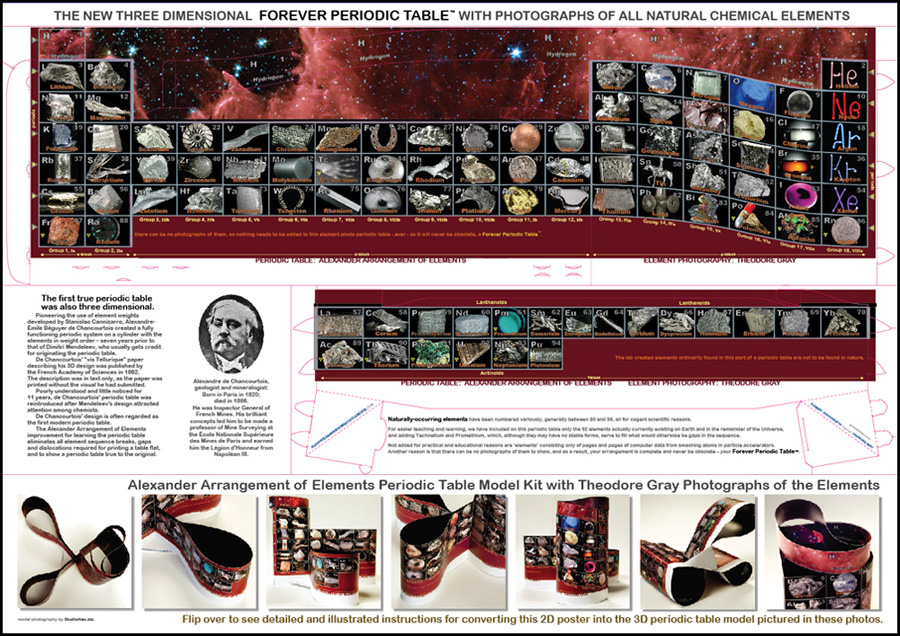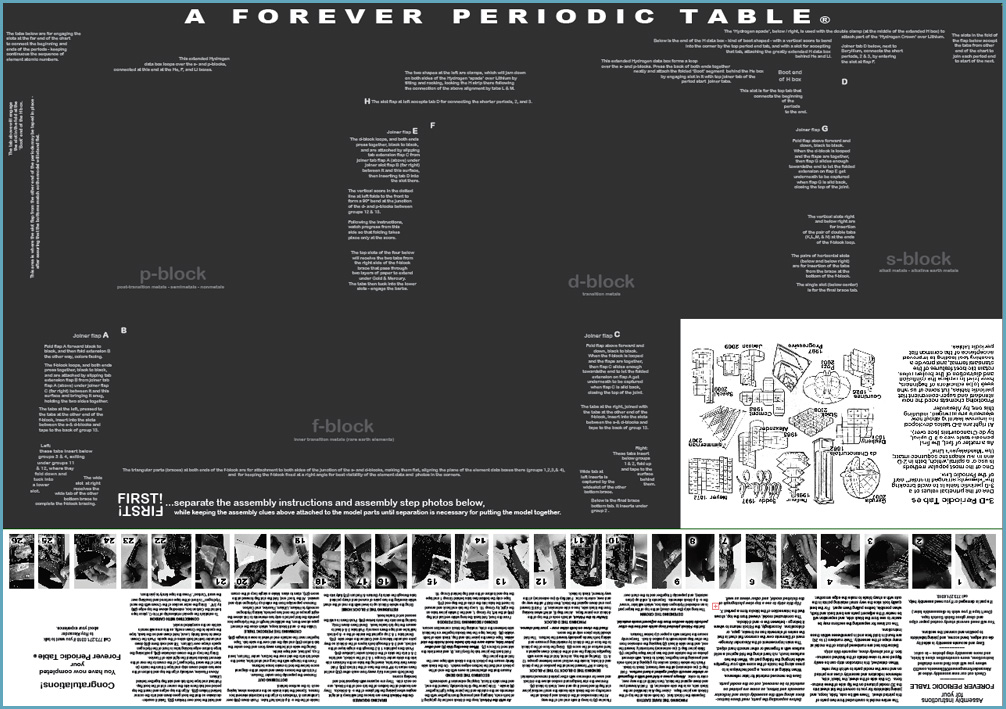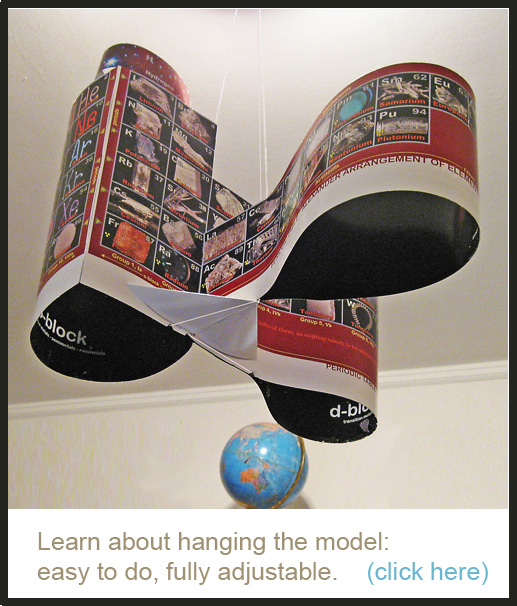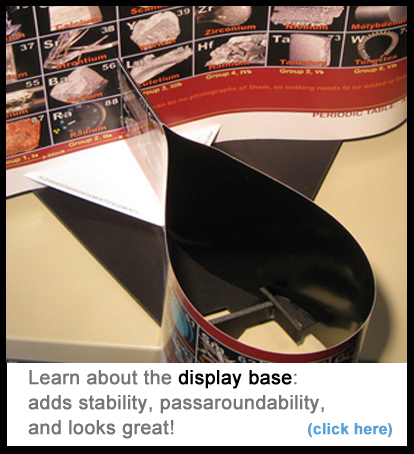|
Front and back of the printed and die cut sheets of the latest
Alexander Arrangement of Elements,
and more than you ever wanted to know about the Chemical Element System Model kit and its various parts.
|
|
|
 Starting at the top front, there is a strip that bears a complete description of the Forever model, that can be used for display, science fair or otherwise. On the reverse side is a bolder and shorter title - white on black (see reverse side of the printing below).
Starting at the top front, there is a strip that bears a complete description of the Forever model, that can be used for display, science fair or otherwise. On the reverse side is a bolder and shorter title - white on black (see reverse side of the printing below).
 The starscape below that is intended to emphasize the immense dominance of hydrogen in the universe by showing the hydrogen clouds of outer space.
The starscape below that is intended to emphasize the immense dominance of hydrogen in the universe by showing the hydrogen clouds of outer space.
 The element data strip that tops the model is concealed in this graphic, defined by the thin red lines that, in this view, show where the die cut divides and describes the forms that are to be removed from the sheet and joined by the user into the finished model.
The element data strip that tops the model is concealed in this graphic, defined by the thin red lines that, in this view, show where the die cut divides and describes the forms that are to be removed from the sheet and joined by the user into the finished model.
 Along the right edge are pointed tabs.
Tabs, like arrowheads, have barbs that hold them into the slots that usually occur at the folds of flaps, like the tall one at the left side of the upper half of the sheet.
Along the right edge are pointed tabs.
Tabs, like arrowheads, have barbs that hold them into the slots that usually occur at the folds of flaps, like the tall one at the left side of the upper half of the sheet.
 Most of the element representations of the periodic table are shown in the boxes of the section below the starscape.
All the groups are indicated, with both their older and later designations. The blocks are identified; s-, d-, and p-block, along the bottom edge of the colored area below the boxes.
Most of the element representations of the periodic table are shown in the boxes of the section below the starscape.
All the groups are indicated, with both their older and later designations. The blocks are identified; s-, d-, and p-block, along the bottom edge of the colored area below the boxes.

|
|
 Each box contains the name, letter symbol, and the atomic number of the element that belongs in that position. The usual wide gap that has always divided the first, second, and third periods is still evident, but when it is looped during assembly, the gap is removed for periods 2 & 3.
Each box contains the name, letter symbol, and the atomic number of the element that belongs in that position. The usual wide gap that has always divided the first, second, and third periods is still evident, but when it is looped during assembly, the gap is removed for periods 2 & 3.
 Period one has a greater gap to fill, which is closed by making the hydrogen box longer so it connects with helium to start the continuity that is maintained throughout the model - just as it was in the first periodic element table, the spiral discovered by Alexandre-Emile Béguyer de Chancourtois.
Period one has a greater gap to fill, which is closed by making the hydrogen box longer so it connects with helium to start the continuity that is maintained throughout the model - just as it was in the first periodic element table, the spiral discovered by Alexandre-Emile Béguyer de Chancourtois.
 At the left and right ends, respectively, are groups of the beginning and end of the periodic table. Marked appropriately in the colored vertical stripe, an arrow shows the referenced direction. When assembled, the end of one period is adjacent to the beginning of the next.
At the left and right ends, respectively, are groups of the beginning and end of the periodic table. Marked appropriately in the colored vertical stripe, an arrow shows the referenced direction. When assembled, the end of one period is adjacent to the beginning of the next.
 Permitting the continuity of elements from period to period is a key feature of both the Vis Tellurique model of the original element arrangement discovery and that of my re-discovery (although I thought it original at the time), the Alexander Arrangement of the Elements. The ramping down in the Alexander Arrangement occurs in the p-block, and this is the patentable feature of the patent I won in the 1970s.
Permitting the continuity of elements from period to period is a key feature of both the Vis Tellurique model of the original element arrangement discovery and that of my re-discovery (although I thought it original at the time), the Alexander Arrangement of the Elements. The ramping down in the Alexander Arrangement occurs in the p-block, and this is the patentable feature of the patent I won in the 1970s.
|

|
|
|
 The red lines below the block names, where the sources of model format and photographs are, show the horizontal slots where the braces from the still separate f-block locking tabs will perform its replacement between the s- and d-blocks. Not as easy to find, are the pair of vertical slots that will receive the pressed-together tabs from both ends of the f-block, correctly, Glenn Seaborg said, that brings all the blocks of the element arrangement together.
The red lines below the block names, where the sources of model format and photographs are, show the horizontal slots where the braces from the still separate f-block locking tabs will perform its replacement between the s- and d-blocks. Not as easy to find, are the pair of vertical slots that will receive the pressed-together tabs from both ends of the f-block, correctly, Glenn Seaborg said, that brings all the blocks of the element arrangement together.
 The f-block, containing boxes for all the Rare Earths and some other transuranium elements has another unique feature, even for an Alexander Arrangement.
The f-block, containing boxes for all the Rare Earths and some other transuranium elements has another unique feature, even for an Alexander Arrangement.
 In that this version was specifically planned as an element photography showpiece the element boxes needed to end where the photos became impossible to take. Simultanneously, this kept emphasis on the simple substances most familiar to the lay audience the Forever is intended for as well as making the a model complete now and for the future - leading the the Chemical Element System Model name.
In that this version was specifically planned as an element photography showpiece the element boxes needed to end where the photos became impossible to take. Simultanneously, this kept emphasis on the simple substances most familiar to the lay audience the Forever is intended for as well as making the a model complete now and for the future - leading the the Chemical Element System Model name.
 While not literally a table (I suppose) the model uses the proven and already convenient to reproduce common periodic table and alters the horizontal plane only, permitting gaps in the shorter periods to be closed by connecting the longer periods end to end, and also, from a communications standpoint, the name allows the general public, well aware of the term 'periodic table' from high school and for its recent (mis)application in myriad novel ways, to identify the relationship to the chemical elements immediately.
While not literally a table (I suppose) the model uses the proven and already convenient to reproduce common periodic table and alters the horizontal plane only, permitting gaps in the shorter periods to be closed by connecting the longer periods end to end, and also, from a communications standpoint, the name allows the general public, well aware of the term 'periodic table' from high school and for its recent (mis)application in myriad novel ways, to identify the relationship to the chemical elements immediately.
 Stated on both the f-block and main sections is the rationale for boxes for artificial elements; "The lab created elements ordinarily found in this part of a periodic table are not to be found in nature, there can be no photographs of them,...
Stated on both the f-block and main sections is the rationale for boxes for artificial elements; "The lab created elements ordinarily found in this part of a periodic table are not to be found in nature, there can be no photographs of them,...
|
|
...so nothing needs to be added to this element photo periodic table - ever - so it will never be obsolete, a Forever Periodic Table." This remains visible on the completed model.
 Another statement, which can be seen on a remove-and-discard segment below the f-block elements is "Naturally-occurring elements have been numbered variously, generally between 80 and 96, all for cogent scientific reasons.
Another statement, which can be seen on a remove-and-discard segment below the f-block elements is "Naturally-occurring elements have been numbered variously, generally between 80 and 96, all for cogent scientific reasons.
 "For easier teaching and learning, we have included on this periodic table only the 92 elements actually currently existing on Earth and in the remainder of the Universe,
and adding Technetium and Promethium, which, although they may have no stable forms, serve to fill what would otherwise be gaps in the sequence.
"For easier teaching and learning, we have included on this periodic table only the 92 elements actually currently existing on Earth and in the remainder of the Universe,
and adding Technetium and Promethium, which, although they may have no stable forms, serve to fill what would otherwise be gaps in the sequence.
 "Not added for practical and educational reasons are 'elements' consisting only of pages and pages of computer data from smashing atoms in particle accelerators.
Another reason is that there can be no photographs of them to show, and as a result, your arrangement is complete and never be obsolete - your Chemical Element System Model.
"Not added for practical and educational reasons are 'elements' consisting only of pages and pages of computer data from smashing atoms in particle accelerators.
Another reason is that there can be no photographs of them to show, and as a result, your arrangement is complete and never be obsolete - your Chemical Element System Model.
 To the left of the the f-block is a remove-and-keep part about, on this side, de Chancourtois, and on the flip side, sketches of a variety of 3D periodic arrangements. Another remove-and-keep part is the series of photos of the completely assembled model, along the bottom, which has the instructions on the flip side, improvements of which can be seen at our
assembly pages and
assembly video.
To the left of the the f-block is a remove-and-keep part about, on this side, de Chancourtois, and on the flip side, sketches of a variety of 3D periodic arrangements. Another remove-and-keep part is the series of photos of the completely assembled model, along the bottom, which has the instructions on the flip side, improvements of which can be seen at our
assembly pages and
assembly video.
 Below, the other side of the printed piece, done in York,PA, at Strine Printing, is primarily black, providing a surface that will not show small smudges that could happen over time with the necessary handling a three-dimensional object invites.
Below, the other side of the printed piece, done in York,PA, at Strine Printing, is primarily black, providing a surface that will not show small smudges that could happen over time with the necessary handling a three-dimensional object invites.

|
|


|
|
|
 The black ink surface has a shine that almost matches the gloss of Scotch transparent tape, permitting its use in aiding assembly by making connections permanent. In the black area are letter indicators that are referred to in the instructions as well as construction 'clues', suggestions about what will happen to that particular segment.
The black ink surface has a shine that almost matches the gloss of Scotch transparent tape, permitting its use in aiding assembly by making connections permanent. In the black area are letter indicators that are referred to in the instructions as well as construction 'clues', suggestions about what will happen to that particular segment.
 These are all either on removed-and-discarded pieces or hidden from view when assembled except for the four block names, which are visible when looking up at a hanging model.
These are all either on removed-and-discarded pieces or hidden from view when assembled except for the four block names, which are visible when looking up at a hanging model.
 Along the top, in this view, is the other side of the more detailed header on the front, giving a display another option. The blocks are identified for reference at assembly and later, when they can be seen from below.
Along the top, in this view, is the other side of the more detailed header on the front, giving a display another option. The blocks are identified for reference at assembly and later, when they can be seen from below.
 The non-black area below is upside down in reference to the black area in the above view. This is so the printing on both sides can be seen when horizontally rotating the piece, especially convenient when using the instructions while occasionally referring to the completed model photos on the reverse side.
The non-black area below is upside down in reference to the black area in the above view. This is so the printing on both sides can be seen when horizontally rotating the piece, especially convenient when using the instructions while occasionally referring to the completed model photos on the reverse side.
 The sketches are of a variety of 3D periodic table arrangements than have been proposed over time.
The sketches are of a variety of 3D periodic table arrangements than have been proposed over time.

|
|
 De Chancourtois' initial discovery is there, and the re-discoveries - M.Courtines', a paper arrangement published in a science magazine, George Gamov's patent drawing found in one of his series of Mr. Tomkins Gets Serious books and his Atom and its Nucleus, as well as the Alexander Arrangement of Elements.
De Chancourtois' initial discovery is there, and the re-discoveries - M.Courtines', a paper arrangement published in a science magazine, George Gamov's patent drawing found in one of his series of Mr. Tomkins Gets Serious books and his Atom and its Nucleus, as well as the Alexander Arrangement of Elements.
 The instructions printed here were based on model prototypes prior to printing that will be valuable for any deprived of your online access to the new and improved ones. The 26 detail step photos are black and white, and instructions not as streamlined as those you can find from AlexanderArrangementofElements.com.
The instructions printed here were based on model prototypes prior to printing that will be valuable for any deprived of your online access to the new and improved ones. The 26 detail step photos are black and white, and instructions not as streamlined as those you can find from AlexanderArrangementofElements.com.

 In all, the Chemical Element System Model Model Kit provides a way of seeing the elements arranged in a way that is novel only because Mendeleev's book printing requirement, accompanied by his predictions and his ability and passion for promotion and the periodic table, while de Chancourtois - not even a chemist - was busy being a high level national figure, having been poorly published and virtually unnoticed by the chemist community.
In all, the Chemical Element System Model Model Kit provides a way of seeing the elements arranged in a way that is novel only because Mendeleev's book printing requirement, accompanied by his predictions and his ability and passion for promotion and the periodic table, while de Chancourtois - not even a chemist - was busy being a high level national figure, having been poorly published and virtually unnoticed by the chemist community.
 I hope you can enjoy the assembly process as well as subsequent ownership and use, and if you wish to use it extensively, you may want to make a base to reduce handling wear.
I hope you can enjoy the assembly process as well as subsequent ownership and use, and if you wish to use it extensively, you may want to make a base to reduce handling wear.

|
|
|
|

|
< BACK
|
AlexanderDESIGN
4851 N. Washtenaw Ave., Chicago, IL 60645 773.271.0318
last update 2/2/16
|


 These are all either on removed-and-discarded pieces or hidden from view when assembled except for the four block names, which are visible when looking up at a hanging model.
These are all either on removed-and-discarded pieces or hidden from view when assembled except for the four block names, which are visible when looking up at a hanging model.
